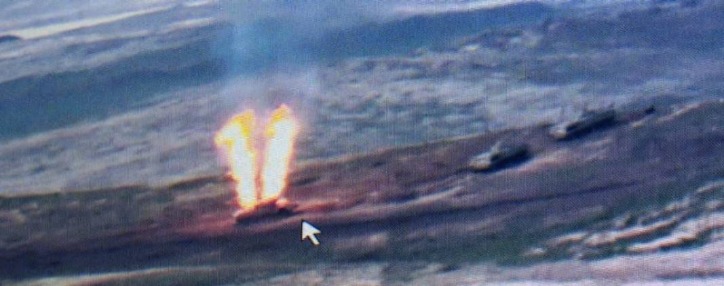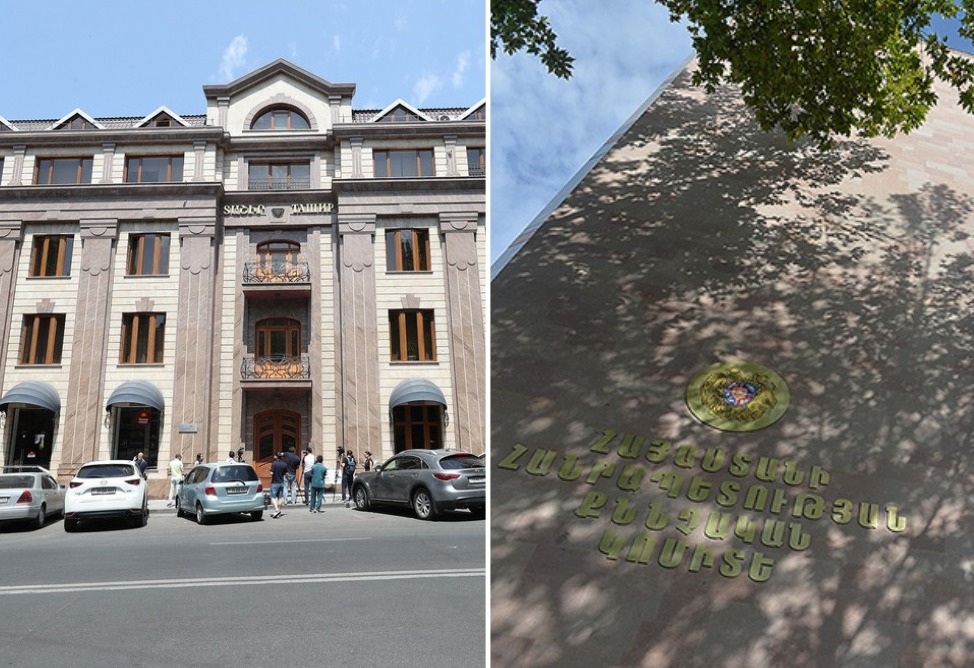Azerbaijan continues shelling settlements in Artsakh – Armenian defense ministry
28.09.2020,
13:18
Azerbaijan continues shelling the settlements of Artsakh, said Artsrun Hovhannisyan, spokesman at the Armenian defense ministry, said Monday at a briefing at the Single Information Center on Monday.

YEREVAN, September 28. /ARKA/. Azerbaijan continues shelling the settlements of Artsakh, said Artsrun Hovhannisyan, spokesman at the Armenian defense ministry, said Monday at a briefing at the Single Information Center on Monday.
"The settlements of Artsakh at the moment remain a target for shelling. In particular, the Azerbaijani artillery continues to shell the city of Martakert," Hovhannisyan said.
Commenting on the statements of Azerbaijan that the Armenian side is striking in settlements and it is striking back, the spokesman of the ministry of defense noted that there is evidence of Azerbaijan's shelling of Armenian settlements.
“We have already proved yesterday that they are striking Stepanakert and there are facts of strikes against Martakert. I don’t want to comment on the rest,” Hovhannisyan said.
Aggravation of the situation in Artsakh
On September 27, at 07:10, Azerbaijani troops launched an offensive along the entire length of the line of contact in Artsakh. According to the defense ministries of Armenia and Artsakh, the enemy launched aerial and rocket fire, but was thrown back on several sections of the contact line. The Azerbaijani side suffered casualties and losses in equipment. In particular, it lost three tanks, two helicopters and three UAVs.
The Azerbaijani Armed Forces are shelling, among other things, peaceful settlements, in particular, the capital of Artsakh, Stepanakert. Armenian Defense Minister Davit Tonoyan held a telephone conversation with the personal representative of the OSCE Chairman-in-Office Andrzej Kasprzyk, introduced him to the situation at the border and said that Azerbaijan had unleashed another provocation.
A state of war and general mobilization are declared in Artsakh and Armenia.
About Karabakh conflict
Karabakh conflict broke out in 1988 when Karabakh, mainly populated by Armenians, declared its independence from Azerbaijan. On December 10, 1991, a few days after the collapse of the Soviet Union, a referendum took place in Nagorno-Karabakh, and the majority of the population (99.89%) voted for secession from Azerbaijan.
Afterwards, large-scale military operations began. As a result, Azerbaijan lost control over Nagorno-Karabakh and the seven regions adjacent to it. Some 30,000 people were killed in this war and about one million people fled their homes.
On May 12, 1994, the Bishkek cease-fire agreement put an end to the military operations. Since 1992, talks brokered by OSCE Minsk Group are being held over peaceful settlement of the conflict. The group is co-chaired by USA, Russia and France. -0---
"The settlements of Artsakh at the moment remain a target for shelling. In particular, the Azerbaijani artillery continues to shell the city of Martakert," Hovhannisyan said.
Commenting on the statements of Azerbaijan that the Armenian side is striking in settlements and it is striking back, the spokesman of the ministry of defense noted that there is evidence of Azerbaijan's shelling of Armenian settlements.
“We have already proved yesterday that they are striking Stepanakert and there are facts of strikes against Martakert. I don’t want to comment on the rest,” Hovhannisyan said.
Aggravation of the situation in Artsakh
On September 27, at 07:10, Azerbaijani troops launched an offensive along the entire length of the line of contact in Artsakh. According to the defense ministries of Armenia and Artsakh, the enemy launched aerial and rocket fire, but was thrown back on several sections of the contact line. The Azerbaijani side suffered casualties and losses in equipment. In particular, it lost three tanks, two helicopters and three UAVs.
The Azerbaijani Armed Forces are shelling, among other things, peaceful settlements, in particular, the capital of Artsakh, Stepanakert. Armenian Defense Minister Davit Tonoyan held a telephone conversation with the personal representative of the OSCE Chairman-in-Office Andrzej Kasprzyk, introduced him to the situation at the border and said that Azerbaijan had unleashed another provocation.
A state of war and general mobilization are declared in Artsakh and Armenia.
About Karabakh conflict
Karabakh conflict broke out in 1988 when Karabakh, mainly populated by Armenians, declared its independence from Azerbaijan. On December 10, 1991, a few days after the collapse of the Soviet Union, a referendum took place in Nagorno-Karabakh, and the majority of the population (99.89%) voted for secession from Azerbaijan.
Afterwards, large-scale military operations began. As a result, Azerbaijan lost control over Nagorno-Karabakh and the seven regions adjacent to it. Some 30,000 people were killed in this war and about one million people fled their homes.
On May 12, 1994, the Bishkek cease-fire agreement put an end to the military operations. Since 1992, talks brokered by OSCE Minsk Group are being held over peaceful settlement of the conflict. The group is co-chaired by USA, Russia and France. -0---



